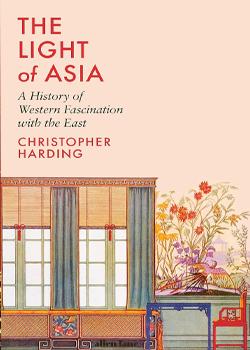The Light of Asia

By Christopher Harding
Allen Lane (2024)
ISBN-13: 978-0241434444
Review by Laurence Green
‘What is real? Who says? How should we live?’ - These are the three questions that lie at the core of Christopher Harding’s eminently readable effort on Asia, expanding on the Japan-centric scope of his previous two books to now encompass the continent as a whole. Wrapped up in these three questions is an attempt to tease out a broader, all-encompassing narrative that pulls on both history and philosophy as approaches to tell a story fundamental to humanity’s existence: what is it about other nations, so far removed from us both spatially and spiritually, that continues to enthral and fascinate us? Harding seeks to paint this as an enduring pattern, across a vast span of years that takes us from ancient times to the present day, a constant, endless searching for a potential greater truth to the world.
Told over three core parts, the opening movements of The Light of Asia - charting antiquity to roughly 1600 - fall very much within the grand historical scope of a type one can imagine from a Peter Frankopan or Simon Schama tome. From the familiar - Marco Polo in China - to the less so - tales of ‘Prester John’, a mediaeval Christian King believed to reside somewhere in India, the early pages of Harding’s narrative dazzle with a wealth of riches; the world map veritably unfurling in real time, as new horizons are unveiled, and new realms (and religions) are revealed to those first Western travellers to the East. The wonder in these early chapters - whether recounting the familiar or unfamiliar - is palpable.
As we move forward in time - the second part of the book taking in the years 1600 to the early 1900s - the fraught history of colonialism and the need for the material riches of Asia rears its head. But more than this, as one chapter puts it, is the ‘search for souls’ - and it is in this central aspect, the tussling of religiosity and the prospect of converting those in the East to Christianity (but also the concurrent flow back to the West of Eastern thought and early translations of Eastern religious texts), that the book takes up what proves to be its core mantle: spirituality and philosophy. What did the East offer by way of its religions that the West did not? Early comparisons in the vein of we-do-this, they-do-that give way in the Enlightenment, via figures like Immanuel Kant, to a more considered thoughtspace by which to consider what the likes of Buddhism and Hinduism might offer. To return to Harding’s core set of questions: ‘What is real? Who says? How should we live?’
The final chapter of the book’s second part draws us into the world of famed mystic Madamme Blavatsky, the Russian-American who through her writings and founding of The Theosophical Society in 1875 caught something of a vogue for Eastern ‘inspired’ spirituality, spurred on by trips to India and Tibet. Following in this vein, the book then doubles down on this interwoven trend for guru-like figures bringing the East to the West; with a number of chapters dominated by an account of Alan Watts - the man who perhaps more than any other, helped to popularise the image of Buddhism in the West. As philosophy meets psychedelics in the heady counterculture of the 1960s, the cultural exchanges spurred on by this Eastern fascination find new and intriguing outlets; chief among the examples cited here being sitar-featuring Beatles tracks like Norwegian Wood. These pop-cultural ‘moments’ serve well to punctuate the more ‘thinky’ philosophical thread of the book’s final third, and if anything emphasise just how much the broader sense of what we now see as commonplace and part of the fabric of Western culture - mindfulness being one of the particularly astute examples presented here - are now subverted and wholly absorbed from their original Eastern point of origin.
Impressively ambitious in its mission, The Light of Asia both stands and falls by its variety - the cornucopia-like approach offering up fascinating tit-bits of memorably witty narrative, but always in an attempt to map one to another, to thread the needle through them all toward a possible end goal. Fans of Harding’s previous books may find their mileage varies here: does the material on Germany’s ‘oriental renaissance’, or trippy 60s beat philosophy, hold as much of a pull as the analysis of the Portuguese Jesuit’s earliest efforts in bringing Christianity to Japan, for example? Imagined as a three-part documentary series, perhaps, it’s easy to see the volume’s punchy narrative hitting home, and the storytelling is never anything less than crisp and lucid - but there is a lot going on here, and the deeper the book gets into the inner philosophical workings of its comparative subject matter - moving from the exterior to the interior, in other words - the more onus it puts on the reader to believe in and keep pace with the importance of these connecting links.
Fascination abounds here though - and one imagines that prompted by one of the many pieces singled out for analysis here, whether it be Victorian poet and journalist Edwin Arnold’s titular The Light of Asia - from which Harding’s book gets its name - or the Hindu Bhagavad Gita itself, like so many who have come before, the sparks of a deeper exploration will be kindled here.

